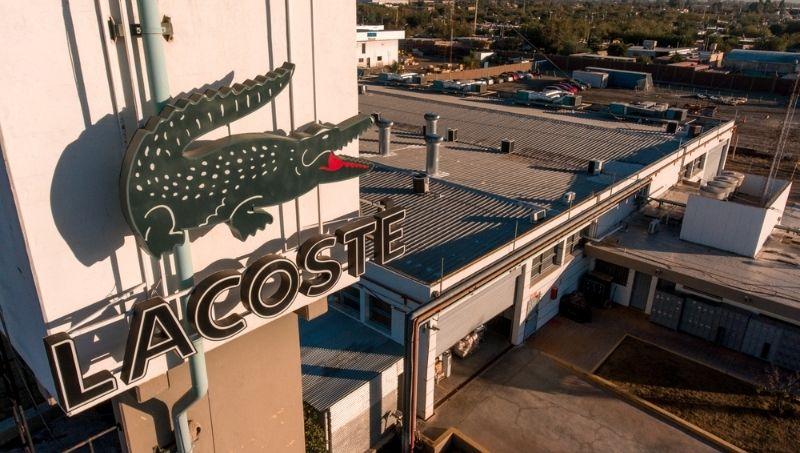The manufacturing plant that Lacoste has in our country has been located in the town of Pocitos -San Juan- since 1988, currently employing about 270 people, and consolidating itself as a model plant, since it has quality certification for export. . This plant, managed 100% by Argentine human capital, is the regional headquarters for Uruguay, Paraguay, Chile and Peru, and as we mentioned before, it is one of the three own plants that the brand has around the world, along with those in France. and Japan.
Cecilia Mascardi, CEO South America of Lacoste, tells us that the San Juan plant focused from the beginning on a single product, thinking of something they could do very well and be efficient in their production, and that product was shirts, which among 85% and 90% are made for internal consumption. Over time, other lines were incorporated, such as gabardine pants, which, like shirts, are made for both men and women, and men's swimwear.
At the local plant, according to Cecilia, some 400,000 garments are being made each year, of which 60% is exported (mainly to Brazil, Chile, the United States and occasionally to France). Of the total produced per year, 75% to date are shirts.
But the pandemic made a change in all areas, and the textile world was not exempt. "The consumption of shirts in the world, with this new way of life that is here to stay, has dropped," Mascardi tells us. For this reason, starting this year the San Juan plant will produce shirts on a smaller scale, going from being 75% of the total garments made to being 60% in 2022. But the plant will add other lines that will be added to the portfolio of products, thanks to the renovations and expansions that were carried out a year and a half ago.

The transformation has already begun, and the plant is about to start working with two lines of men's underwear (tripacks of boxers and briefs), which will be entirely destined for the Brazilian market, but by 2022 they plan to double their production and also supply the Brazilian market. local market. "It is a product that we can make at a very competitive price and 90% with local raw materials," says Cecilia.
And by the end of this year the factory also wants to start making pima t-shirts (exclusive cotton from Peru that has the characteristic of being softer and finer), both for men and women, and launch them on the local market in the first half of 2022. With this new production, the finished shirt will no longer be imported to import only the fabric and make the product here.
Lacoste's plans for the interior of the country
The brand in Argentina has 16 own boutiques, 5 outlets (all in Buenos Aires) and 18 exclusive franchises, including the last two that opened in Mendoza and Comodoro Rivadavia this year.
In 2020, the brand launched Le Club Evolution worldwide, a concept that recently arrived in Argentina -at a location in Alto Palermo-, with which they intend to update more and more the ways in which the consumer buys, having movable mannequins , a better display of footwear, among other details.
Lacoste wants to replicate this new format in the interior of the country as well, and according to Cecilia, the remodeling of two of its franchises (one in Tucumán and another in San Juan) has already been confirmed for the second half of the year, seeking to evolve its stores, double its size and present this concept in its provinces.
"In Córdoba we are full. We have a very good acceptance and a very good presence", mentions Cecilia Mascardi. In the province they have 3 own stores -located in Nuevocentro, Córdoba Shopping and Patio Olmos-, and 4 franchises -in Paseo del Jockey, Villa Allende, Río Cuarto and Río Tercero-.
Lacoste's plans for Córdoba are to remodel Patio Olmos (its own store), moving to a larger location within the same shopping center, and it also wants to transform, possibly through a franchise, the store they have in Córdoba Shopping. They also want to continue improving their bets in Río Tercero and Río Cuarto, through current franchises and multi-brand channels, with which they also enter with a good presence, according to Cecilia.
Lacoste wants to be present with its own stores in the most important locations in Argentina such as Córdoba, Rosario and Buenos Aires, and in the rest of the country to establish itself through multi-brands and franchises, “that is a bit of the mechanics where we are going”, highlights Cecilia, adding: "The number is going to grow a lot in franchises, and in boutiques we intend to maintain it, and improve them."
To conclude, Cecilia Mascardi expresses: "The great dynamics of our brand is that it is present throughout the value chain, it produces, it has a marketing that is anchored not only in its own but in strategic partners SMEs, which come with multi-brand and mono-brand format , exports and generates direct and indirect employment for more than 1,500 people in Argentina".


